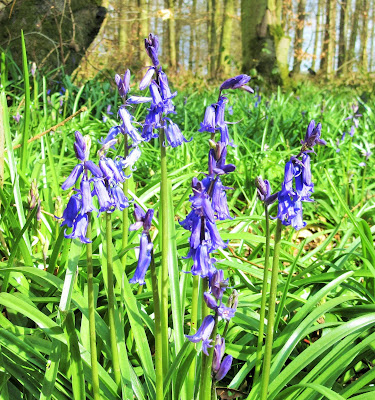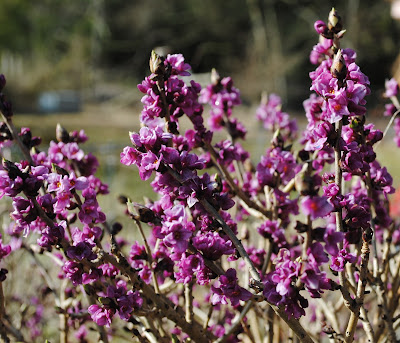What could possibly make these people get down on their hands and knees and stick their bottoms in the air?
Well moss, of course! No, they're not praying to the moss gods, they're using hand lenses to look at a tiny moss growing on the chalk slope. This morning I attended a moss walk on Grangelands that was led by Peter Creed and organised by BBOWT. It's my local nature reserve and I visit regularly, but I still love to find out some of its secrets.
We walked through the woods, then out onto the chalk grassland, looking at different mosses and liverworts as we went. Our most exciting discovery was a rare moss called fir tamarisk-moss that was growing all over the chalk slope. It really did look like a tiny fir tree and is found on unimproved chalk grassland in the South of England.
 |
| fir tamarisk-moss |
I must have waked there hundreds of times and I've never noticed it before, so it shows how it really pays to get down on your hands and knees and have a close look. Some of our group were so excited to find it that they fell over!
Mosses come in one of two forms, either tufted cushions (agrocarps) or long, tendril-like shoots(pleurocarps). They don't have flowers, but produce capsules on a stem called a seta. The capsule is covered by a calyptra while it matures, which eventually drops off. The capsule has a lid on it, which reveals tiny teeth called peristomes.
 |
Creeping feather moss, with bright red seta and capsules that are still
developing and are covered by the pale green calyptra |
 |
Rough-stalked feather-moss, with deep red seta and capsules. Look closely
and you can see capsules with a lid on (right) and showing the peristomes (left) |
Mosses come in all shapes and sizes and are surprisingly particular about their habitats and what they'll grow on. English rock bristle is tiny (the leaves are about 1mm long) and grows only on chalk fragments. We definitely needed a hand lens to get a good look at this miniature moss.
 |
| English rock bristle |
 |
| English rock bristle growing on a chalk fragment |
In contrast, rambling tail moss is a large yellow-green moss commonly found in calcareous woodland. Often seen tumbling over banks, this is an easy one to spot.
 |
| Rambling tail moss |
Spiral extinguisher moss grows on bare chalk in the Chilterns and has leaves that form a floret. It's one of the mosses that doesn't produce capsules.
 |
| Spiral extinguisher moss |
There are some mosses that are even more specific. We found one tiny clump of upright pottia growing on an ant hill out on the chalk grassland. It likes disturbed soil, so it even had to be an ant hill that had been dug into by something.
 |
| Yellow meadow ant hill that has been damaged on the left hand side |
 |
| Upright pottia - a tint moss with red spherical capsules |
Identifying moss can be a tricky business, especially as it can change shape and even colour when it dries out. We found some intermediate screw moss, growing on the roots of a beech tree, that had leaves that were twisted tight and were very dark in colour. We sprayed it with some water and it completely changed its appearance in a matter of seconds. The leaves opened out and it turned bright green.
 |
| Intermediary screw moss - before being sprayed with water |
 |
| Intermediary screw moss - after being sprayed with water |
Liverworts are bryophytes like mosses, but they look more primitive and lack a central nerve in the leaf. We found two today, but they couldn't have been more different. The first was wall scalewort, one of the largest liverworts, which was growing around the base of the beech trees.
 |
| Wall scalewort |
 |
| Wall scalewort |
The second liverwort we found had a lovely name, top notchwort, but was tiny and looked more like a tiny green fuzz growing on the bare chalk slopes.
 |
| Top notchwort |
And to finish ... the wonderful view across Grangelands!


















































